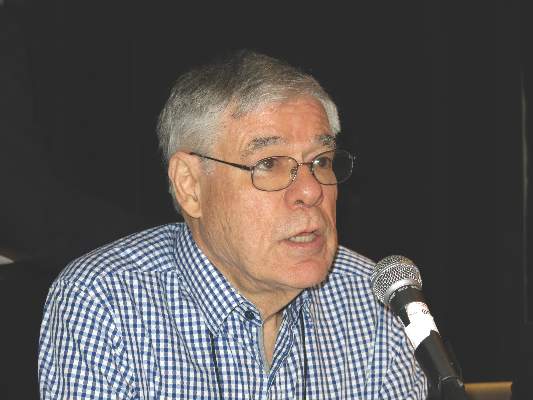User login
WASHINGTON – Sofpironium bromide, a newly developed “soft” anticholinergic gel, improved clinical outcomes and quality of life in patients with severe hyperhidrosis.
The drug is designed to work as an effective anticholinergic, but is metabolized and excreted much more quickly. This limits the possibility of troublesome systemic anticholinergic side effects, Dr. David M. Pariser said at the annual meeting of the American Academy of Dermatology.
“The main one we saw was vision issues, which occurred in about 8% of the patients,” who participated in a phase IIb randomized study, said Dr. Pariser, a dermatologist in Norfolk, Va. “We also saw urinary hesitancy, dry eyes, and dry lips. But these were nothing unexpected, and didn’t occur at an unexpected rate,” he added.
Sofpironium bromide (BBI-4000; BrickellBiotech) is a new molecular entity designed to bind to the M3 AC (acetylcholine) receptor on sweat glands – inhibiting sweat production – but to incompletely bind to systemic AC receptors. Thus, it exerts most of its effects locally, is rapidly metabolized, and exhibits very low systemic absorption, according to the company website.
The phase IIb study randomized 189 subjects to BBI-4000 in 5%, 10%, and 15% concentrations, or a placebo gel. All of the subjects had axillary hyperhidrosis scores of 3 or 4 on the Hyperhidrosis Disease Severity Scale (HDSS) – a 1-4 scale – and/or sweat at least 50 mg per 5 minutes per axilla.
Subjects applied the gel to underarms once daily for 28 days. Key endpoints were significant changes on the HDSS scale and the Hyperhidrosis Disease Severity Measure Axillary (HDSM-Ax), an axillary-specific scale developed by the company.
Positive results occurred in a dose-dependent outcome, with the 15% gel being the most effective. At that concentration, 38% of subjects achieved at least a 2 point improvement on the HDSS scale vs. 12% of those using the placebo (P less than .01).
On the HDSM-Ax, almost 45% of the high dose group and 19.5% of the placebo group achieved at least a 2 point improvement (P = .01). Those in the high dose group also produced significantly less sweat by day 29 than those in the placebo group.
All of these results were considered clinically significant, Dr. Pariser said.
About 10% of subjects in both groups experienced an application site reaction. Another 10% experienced a systemic anticholinergic adverse event.
Based on the positive results, BrickellBiotech intends to evaluate the 15% gel in a phase III study, Dr. Pariser said.
He is a consultant for the company. BrickellBiotech sponsored the study.
WASHINGTON – Sofpironium bromide, a newly developed “soft” anticholinergic gel, improved clinical outcomes and quality of life in patients with severe hyperhidrosis.
The drug is designed to work as an effective anticholinergic, but is metabolized and excreted much more quickly. This limits the possibility of troublesome systemic anticholinergic side effects, Dr. David M. Pariser said at the annual meeting of the American Academy of Dermatology.
“The main one we saw was vision issues, which occurred in about 8% of the patients,” who participated in a phase IIb randomized study, said Dr. Pariser, a dermatologist in Norfolk, Va. “We also saw urinary hesitancy, dry eyes, and dry lips. But these were nothing unexpected, and didn’t occur at an unexpected rate,” he added.
Sofpironium bromide (BBI-4000; BrickellBiotech) is a new molecular entity designed to bind to the M3 AC (acetylcholine) receptor on sweat glands – inhibiting sweat production – but to incompletely bind to systemic AC receptors. Thus, it exerts most of its effects locally, is rapidly metabolized, and exhibits very low systemic absorption, according to the company website.
The phase IIb study randomized 189 subjects to BBI-4000 in 5%, 10%, and 15% concentrations, or a placebo gel. All of the subjects had axillary hyperhidrosis scores of 3 or 4 on the Hyperhidrosis Disease Severity Scale (HDSS) – a 1-4 scale – and/or sweat at least 50 mg per 5 minutes per axilla.
Subjects applied the gel to underarms once daily for 28 days. Key endpoints were significant changes on the HDSS scale and the Hyperhidrosis Disease Severity Measure Axillary (HDSM-Ax), an axillary-specific scale developed by the company.
Positive results occurred in a dose-dependent outcome, with the 15% gel being the most effective. At that concentration, 38% of subjects achieved at least a 2 point improvement on the HDSS scale vs. 12% of those using the placebo (P less than .01).
On the HDSM-Ax, almost 45% of the high dose group and 19.5% of the placebo group achieved at least a 2 point improvement (P = .01). Those in the high dose group also produced significantly less sweat by day 29 than those in the placebo group.
All of these results were considered clinically significant, Dr. Pariser said.
About 10% of subjects in both groups experienced an application site reaction. Another 10% experienced a systemic anticholinergic adverse event.
Based on the positive results, BrickellBiotech intends to evaluate the 15% gel in a phase III study, Dr. Pariser said.
He is a consultant for the company. BrickellBiotech sponsored the study.
WASHINGTON – Sofpironium bromide, a newly developed “soft” anticholinergic gel, improved clinical outcomes and quality of life in patients with severe hyperhidrosis.
The drug is designed to work as an effective anticholinergic, but is metabolized and excreted much more quickly. This limits the possibility of troublesome systemic anticholinergic side effects, Dr. David M. Pariser said at the annual meeting of the American Academy of Dermatology.
“The main one we saw was vision issues, which occurred in about 8% of the patients,” who participated in a phase IIb randomized study, said Dr. Pariser, a dermatologist in Norfolk, Va. “We also saw urinary hesitancy, dry eyes, and dry lips. But these were nothing unexpected, and didn’t occur at an unexpected rate,” he added.
Sofpironium bromide (BBI-4000; BrickellBiotech) is a new molecular entity designed to bind to the M3 AC (acetylcholine) receptor on sweat glands – inhibiting sweat production – but to incompletely bind to systemic AC receptors. Thus, it exerts most of its effects locally, is rapidly metabolized, and exhibits very low systemic absorption, according to the company website.
The phase IIb study randomized 189 subjects to BBI-4000 in 5%, 10%, and 15% concentrations, or a placebo gel. All of the subjects had axillary hyperhidrosis scores of 3 or 4 on the Hyperhidrosis Disease Severity Scale (HDSS) – a 1-4 scale – and/or sweat at least 50 mg per 5 minutes per axilla.
Subjects applied the gel to underarms once daily for 28 days. Key endpoints were significant changes on the HDSS scale and the Hyperhidrosis Disease Severity Measure Axillary (HDSM-Ax), an axillary-specific scale developed by the company.
Positive results occurred in a dose-dependent outcome, with the 15% gel being the most effective. At that concentration, 38% of subjects achieved at least a 2 point improvement on the HDSS scale vs. 12% of those using the placebo (P less than .01).
On the HDSM-Ax, almost 45% of the high dose group and 19.5% of the placebo group achieved at least a 2 point improvement (P = .01). Those in the high dose group also produced significantly less sweat by day 29 than those in the placebo group.
All of these results were considered clinically significant, Dr. Pariser said.
About 10% of subjects in both groups experienced an application site reaction. Another 10% experienced a systemic anticholinergic adverse event.
Based on the positive results, BrickellBiotech intends to evaluate the 15% gel in a phase III study, Dr. Pariser said.
He is a consultant for the company. BrickellBiotech sponsored the study.
AT AAD 16
Key clinical point: An investigational anticholinergic gel had a significant impact on the severity of hyperhidrosis in individuals with severe axillary hyperhidrosis.
Major finding: Almost 40% of patients treated with the 15% concentration of sofpironium bromide gel experienced an improvement of at least 2 points on a scale measuring hyperhidrosis severity, vs. 12% of those using the placebo (P less than .01).
Data source: The 28-day study evaluated the impact of treatment in 189 subjects with severe hyperhidrosis.
Disclosures: BrickellBiotech sponsored the study. Dr. Pariser is a consultant for the company.

